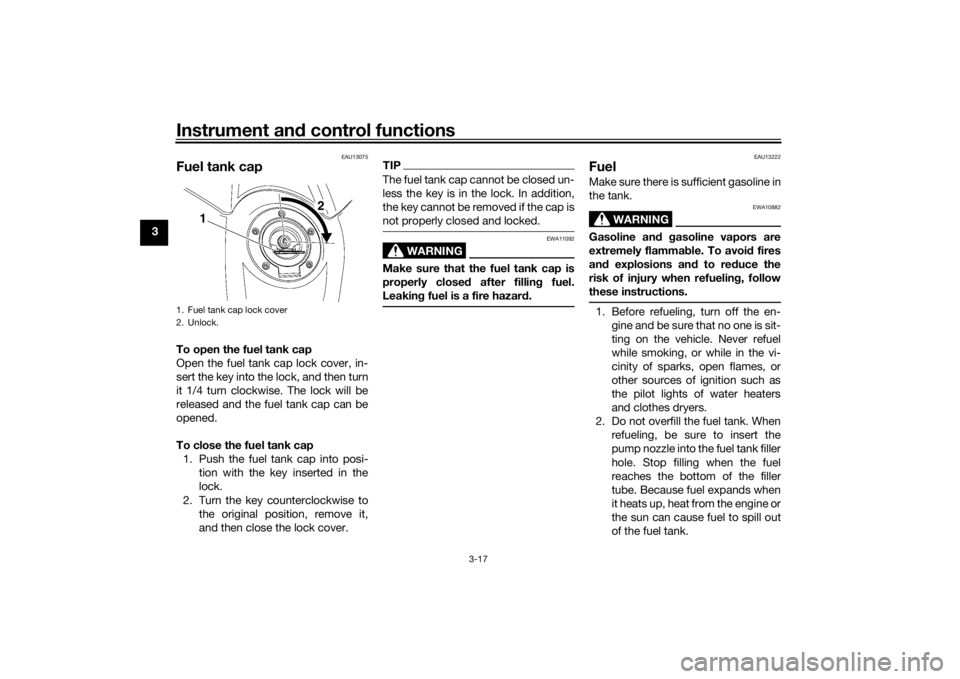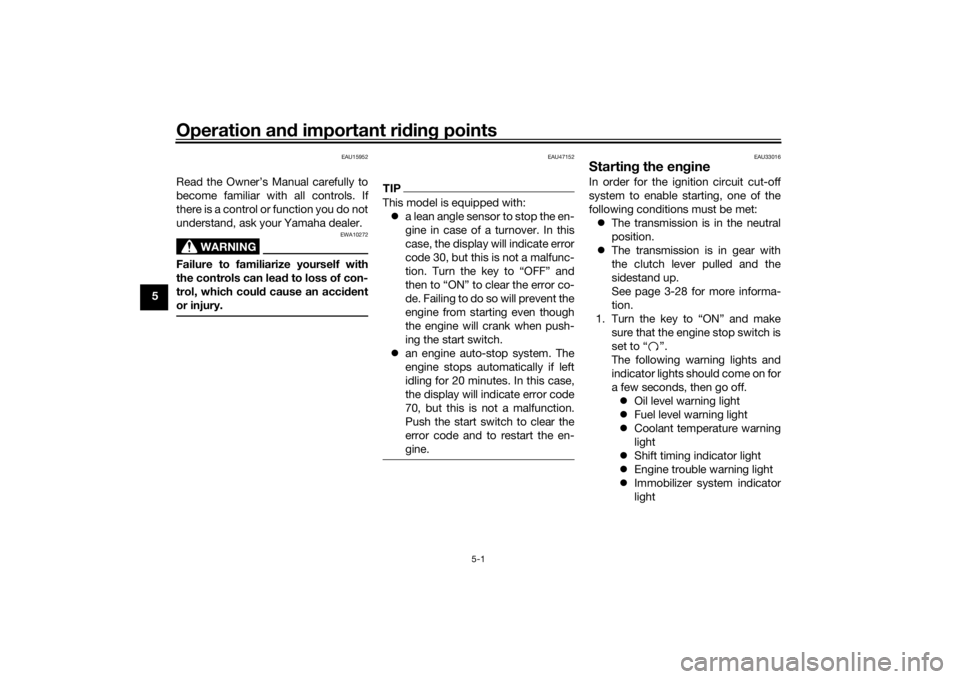ignition YAMAHA YZF-R6 2016 Owners Manual
[x] Cancel search | Manufacturer: YAMAHA, Model Year: 2016, Model line: YZF-R6, Model: YAMAHA YZF-R6 2016Pages: 112, PDF Size: 2.57 MB
Page 6 of 112

Table of contentsSafety information ............................ 1-1
Description ....................................... 2-1
Left view ......................................... 2-1
Right view ....................................... 2-2
Controls and instruments ............... 2-3
Instrument an d control functions ... 3-1
Immobilizer system......................... 3-1
Main switch/steering lock............... 3-2
Indicator lights and warning lights............................................ 3-4
Multi-function meter unit ................ 3-8
Handlebar switches ...................... 3-14
Clutch lever .................................. 3-15
Shift pedal .................................... 3-15
Brake lever.................................... 3-16
Brake pedal .................................. 3-16
Fuel tank cap ................................ 3-17
Fuel ............................................... 3-17
Fuel tank breather hose and overflow hose ............................ 3-19
Catalytic converters ..................... 3-19
Seats ............................................ 3-20
Helmet holding cable.................... 3-21
Rear view mirrors.......................... 3-22
Adjusting the front fork ................. 3-22
Adjusting the shock absorber assembly ................................... 3-24
Luggage strap holders ................. 3-27
EXUP system ................................ 3-27 Sidestand ...................................... 3-28
Ignition circuit cut-off system ....... 3-28
For your safety – pre-operation
checks ............................................... 4-1
Operation an d important ri din g
points ................................................. 5-1
Starting the engine .......................... 5-1
Shifting ............................................ 5-2
Tips for reducing fuel consumption ................................ 5-3
Engine break-in ............................... 5-3
Parking ............................................ 5-4
Perio dic maintenance an d
a d justment ........................................ 6-1
Owner’s tool kit ............................... 6-2
Periodic maintenance chart for the emission control system .............. 6-3
General maintenance and lubrication chart ........................... 6-4
Removing and installing cowlings
and panels ................................... 6-8
Checking the spark plugs ............. 6-12
Engine oil and oil filter cartridge.... 6-13
Coolant.......................................... 6-16
Air filter element ............................ 6-19
Checking the engine idling speed ......................................... 6-19 Checking the throttle grip free
play ............................................ 6-20
Valve clearance............................. 6-20
Tires .............................................. 6-20
Cast wheels .................................. 6-23
Adjusting the clutch lever free play ............................................ 6-23
Checking the brake lever free
play ............................................ 6-24
Brake light switches ..................... 6-24
Checking the front and rear brake pads .......................................... 6-25
Checking the brake fluid level ...... 6-25
Changing the brake fluid .............. 6-27
Drive chain slack........................... 6-27
Cleaning and lubricating the drive chain ................................. 6-29
Checking and lubricating the cables ........................................ 6-29
Checking and lubricating the
throttle grip and cable ............... 6-30
Checking and lubricating the brake and shift pedals............... 6-30
Checking and lubricating the brake and clutch levers ............. 6-31
Checking and lubricating the
sidestand................................... 6-31
Lubricating the swingarm pivots......................................... 6-32
Checking the front fork ................. 6-32
Checking the steering................... 6-33U2CXE2E0.book Page 1 Tuesday, June 9, 2015 5:04 PM
Page 17 of 112

Instrument and control functions
3-2
3
Keep other immo bilizer system
keys away from the main switch
as they may cause si gnal inter-
ference.
EAU10474
Main switch/steerin g lockThe main switch/steering lock controls
the ignition and lighting systems, and is
used to lock the steering. The various
positions are described below.TIPBe sure to use the standard key (black
bow) for regular use of the vehicle. To
minimize the risk of losing the code re-
registering key (red bow), keep it in a
safe place and only use it for code re-
registering.
EAU38531
ON
All electrical circuits are supplied with
power; the meter lighting, taillight, li-
cense plate light and auxiliary light
come on, and the engine can be start-
ed. The key cannot be removed.TIPThe headlight comes on automatically
when the engine is started and stays
on until the key is turned to “OFF”,
even if the engine stalls.
EAU10662
OFF
All electrical systems are off. The key
can be removed.
WARNING
EWA10062
Never turn the key to “OFF” or
“LOCK” while the vehicle is movin g.
Otherwise the electrical systems will
b e switche d off, which may result in
loss of control or an acci dent.
P
ON
OFF
LOCK
U2CXE2E0.book Page 2 Tuesday, June 9, 2015 5:04 PM
Page 32 of 112

Instrument and control functions
3-17
3
EAU13075
Fuel tank capTo open the fuel tank cap
Open the fuel tank cap lock cover, in-
sert the key into the lock, and then turn
it 1/4 turn clockwise. The lock will be
released and the fuel tank cap can be
opened.
To close the fuel tank cap
1. Push the fuel tank cap into posi- tion with the key inserted in the
lock.
2. Turn the key counterclockwise to the original position, remove it,
and then close the lock cover.
TIPThe fuel tank cap cannot be closed un-
less the key is in the lock. In addition,
the key cannot be removed if the cap is
not properly closed and locked.
WARNING
EWA11092
Make sure that the fuel tank cap is
properly close d after fillin g fuel.
Leakin g fuel is a fire hazar d.
EAU13222
FuelMake sure there is sufficient gasoline in
the tank.
WARNING
EWA10882
Gasoline an d g asoline vapors are
extremely flammab le. To avoid fires
an d explosions an d to re duce the
risk of injury when refuelin g, follow
these instructions.1. Before refueling, turn off the en- gine and be sure that no one is sit-
ting on the vehicle. Never refuel
while smoking, or while in the vi-
cinity of sparks, open flames, or
other sources of ignition such as
the pilot lights of water heaters
and clothes dryers.
2. Do not overfill the fuel tank. When refueling, be sure to insert the
pump nozzle into the fuel tank filler
hole. Stop filling when the fuel
reaches the bottom of the filler
tube. Because fuel expands when
it heats up, heat from the engine or
the sun can cause fuel to spill out
of the fuel tank.
1. Fuel tank cap lock cover
2. Unlock.
1 2
U2CXE2E0.book Page 17 Tuesday, June 9, 2015 5:04 PM
Page 43 of 112

Instrument and control functions
3-28
3
EAU15306
Si destan dThe sidestand is located on the left
side of the frame. Raise the sidestand
or lower it with your foot while holding
the vehicle upright.TIPThe built-in sidestand switch is part of
the ignition circuit cut-off system,
which cuts the ignition in certain situa-
tions. (See the following section for an
explanation of the ignition circuit cut-
off system.)
WARNING
EWA10242
The vehicle must not b e ridden with
the si destan d d own, or if the si de-
stan d cannot b e properly move d up
(or does not stay up), otherwise the
si destan d coul d contact the g round
an d d istract the operator, resultin g
in a possi ble loss of control.
Yamaha’s i gnition circuit cut-off
system has been desi gne d to assist
the operator in fulfilling the respon-
si bility of raisin g the si destan d b e-
fore startin g off. Therefore, check this system re
gularly an d have a
Yamaha dealer repair it if it does not
function properly.
EAU44893
I g nition circuit cut-off systemThe ignition circuit cut-off system
(comprising the sidestand switch,
clutch switch and neutral switch) has
the following functions.
It prevents starting when the
transmission is in gear and the
sidestand is up, but the clutch le-
ver is not pulled.
It prevents starting when the
transmission is in gear and the
clutch lever is pulled, but the side-
stand is still down.
It cuts the running engine when
the transmission is in gear and the
sidestand is moved down.
Periodically check the operation of the
ignition circuit cut-off system accord-
ing to the following procedure.
U2CXE2E0.book Page 28 Tuesday, June 9, 2015 5:04 PM
Page 47 of 112

For your safety – pre-operation checks
4-3
4
Chassis fasteners• Make sure that all nuts, bolts and screws are properly tightened.
• Tighten if necessary. —
Instruments, li ghts, si gnals
an d switches • Check operation.
• Correct if necessary.
—
Si destan d switch • Check operation of ignition circuit cut-off system.
• If system is not working correctly, have Yamaha dealer check vehicle. 3-28
ITEM CHECKS PAGE
U2CXE2E0.book Page 3 Tuesday, June 9, 2015 5:04 PM
Page 48 of 112

Operation and important rid ing points
5-1
5
EAU15952
Read the Owner’s Manual carefully to
become familiar with all controls. If
there is a control or function you do not
understand, ask your Yamaha dealer.
WARNING
EWA10272
Failure to familiarize yourself with
the controls can lead to loss of con-
trol, which coul d cause an acci dent
or injury.
EAU47152
TIPThis model is equipped with: a lean angle sensor to stop the en-
gine in case of a turnover. In this
case, the display will indicate error
code 30, but this is not a malfunc-
tion. Turn the key to “OFF” and
then to “ON” to clear the error co-
d e . F ai l in g to do s o wi ll pr e v e nt the
engine from starting even though
the engine will crank when push-
ing the start switch.
an engine auto-stop system. The
engine stops automatically if left
idling for 20 minutes. In this case,
the display will indicate error code
70, but this is not a malfunction.
Push the start switch to clear the
error code and to restart the en-
gine.
EAU33016
Startin g the en gineIn order for the ignition circuit cut-off
system to enable starting, one of the
following conditions must be met:
The transmission is in the neutral
position.
The transmission is in gear with
the clutch lever pulled and the
sidestand up.
See page 3-28 for more informa-
tion.
1. Turn the key to “ON” and make sure that the engine stop switch is
set to “ ”.
The following warning lights and
indicator lights should come on for
a few seconds, then go off. Oil level warning light
Fuel level warning light
Coolant temperature warning
light
Shift timing indicator light
Engine trouble warning light
Immobilizer system indicator
light
U2CXE2E0.book Page 1 Tuesday, June 9, 2015 5:04 PM
Page 86 of 112

Periodic maintenance an d a djustment
6-35
6
EAU23708
Replacin g the fusesThe main fuse, the fuel injection sys-
tem fuse, and fuse box 1 are located
under the rider seat. (See page 3-20.)TIPTo access the fuel injection system
fuse, remove the starter relay cover by
pulling it upward.
Fuse box 2 is located under panel A.
(See page 6-8.)
If a fuse is blown, replace it as follows.
1. Turn the key to “OFF” and turn off the electrical circuit in question.
2. Remove the blown fuse, and then install a new fuse of the specified
amperage. WARNING! Do not
use a fuse of a hi gher ampera ge
ratin g than recommen ded to avoi
d causin g extensive d am-
a g e to the electrical system an d
possi bly a fire.
[EWA15132]
3. Turn the key to “ON” and turn on
the electrical circuit in question to
check if the device operates.
4. If the fuse immediately blows again, have a Yamaha dealer
check the electrical system.
1. Main fuse
2. Fuel injection system spare fuse
3. Starter relay cover
4. Fuel injection system fuse
5. Fuse box 1
6. Backup fuse (for clock and immobilizer sys-tem)
7. Electronic throttle valve fuse
8. Spare fuse
2
1
5
6
3
748
1. Fuse box 2
2. Left radiator fan motor fuse
3. Right radiator fan motor fuse
4. Signaling system fuse
5. Ignition fuse
6. Taillight fuse
7. Headlight fuse
8. Spare fuse
Specifie d fuses:
Main fuse: 50.0 A
Fuel injection system fuse:
15.0 A
Electronic throttle valve fuse: 7.5 A
Backup fuse: 7.5 A
Radiator fan motor fuse:
15.0 A × 2
Ignition fuse: 15.0 A
Signaling system fuse: 10.0 A
Taillight fuse:
7.5 A
Headlight fuse: 15.0 A
U2CXE2E0.book Page 35 Tuesday, June 9, 2015 5:04 PM
Page 95 of 112

Periodic maintenance an d a djustment
6-44
6
EAU25872
Trou bleshootin gAlthough Yamaha motorcycles receive
a thorough inspection before shipment
from the factory, trouble may occur
during operation. Any problem in the
fuel, compression, or ignition systems,
for example, can cause poor starting
and loss of power.
The following troubleshooting charts
represent quick and easy procedures
for checking these vital systems your-
self. However, should your motorcycle
require any repair, take it to a Yamaha
dealer, whose skilled technicians have
the necessary tools, experience, and
know-how to service the motorcycle
properly.
Use only genuine Yamaha replace-
ment parts. Imitation parts may look
like Yamaha parts, but they are often
inferior, have a shorter service life and
can lead to expensive repair bills.
WARNING
EWA15142
When checkin g the fuel system, d o
not smoke, an d make sure there are
no open flames or sparks in the ar-
ea, inclu din g pilot li ghts from water heaters or furnaces. Gasoline or
g
asoline vapors can i gnite or ex-
plo de, causin g severe injury or prop-
erty damag e.
U2CXE2E0.book Page 44 Tuesday, June 9, 2015 5:04 PM
Page 96 of 112

Periodic maintenance an d a djustment
6-45
6
EAU42505
Trou bleshootin g chartsStartin g pro blems or poor en gine performance
Check the fuel level in
the fuel tank.1. Fuel
There is enough fuel.
There is no fuel.
Check the battery.
Supply fuel.
The engine does not start.
Check the battery.
Remove the spark plugs
and check the electrodes.3. Ignition
Wipe off with a dry cloth and correct the
spark plug gaps, or replace the spark plugs.
Have a Yamaha dealer check the vehicle.
Operate the electric starter.4. Compression
There is compression.
There is no compression.
The engine does not start.
Have a Yamaha dealer check the vehicle.Have a Yamaha dealer check the vehicle.
The engine does not start.
Check the compression.
Operate the electric starter.2. Battery
The engine turns over
quickly.
The engine turns over
slowly.
The engine does not start.
Check the ignition.
The battery is good.Check the battery lead connections,
and have a Yamaha dealer charge
the battery if necessary.
DryWet
Operate the electric starter.
U2CXE2E0.book Page 45 Tuesday, June 9, 2015 5:04 PM
Page 104 of 112

Specifications
8-2
8
6th:1.150 (23/20)
Chassis:Frame type:
Diamond
Caster angle: 24.00 °
Trail: 97 mm (3.8 in)Front tire:Type:Tubeless
Size: 120/70 ZR17M/C (58W)
Manufacturer/model:
BRIDGESTONE/BT016FF
Manufacturer/model: DUNLOP/Qualifier PTMRear tire:Type:
Tubeless
Size: 180/55 ZR17M/C (73W)
Manufacturer/model: BRIDGESTONE/BT016RF
Manufacturer/model:
DUNLOP/Qualifier PTMLoa din g:Maximum load:
186 kg (410 lb)
(Total weight of rider, passenger, cargo
and accessories)
Tire air pressure (measure d on col d
tires):Up to 90 kg (198 lb) load:
Front: 250 kPa (2.50 kgf/cm², 36 psi)
Rear:
290 kPa (2.90 kgf/cm², 42 psi)
90 kg (198 lb) load - maximum load: Front:
250 kPa (2.50 kgf/cm², 36 psi)
Rear: 290 kPa (2.90 kgf/cm², 42 psi)
High-speed riding: Front: 250 kPa (2.50 kgf/cm², 36 psi)
Rear: 290 kPa (2.90 kgf/cm², 42 psi)Front wheel:Wheel type:Cast wheel
Rim size: 17M/CxMT3.50Rear wheel:Wheel type:Cast wheel
Rim size: 17M/CxMT5.50Front brake:Type:
Hydraulic dual disc brake
Specified brake fluid: DOT 4
Rear brake:Type:
Hydraulic single disc brake
Specified brake fluid:
DOT 4Front suspension:Type:Telescopic fork
Spring:
Coil spring
Shock absorber: Hydraulic damper
Wheel travel: 115 mm (4.5 in)Rear suspension:Type:Swingarm (link suspension)
Spring: Coil spring
Shock absorber:
Gas-hydraulic damper
Wheel travel: 120 mm (4.7 in)Electrical system:System voltage:
12 V
Ignition system: TCI
Charging system: AC magnetoBattery:Model:YTZ10S
U2CXE2E0.book Page 2 Tuesday, June 9, 2015 5:04 PM